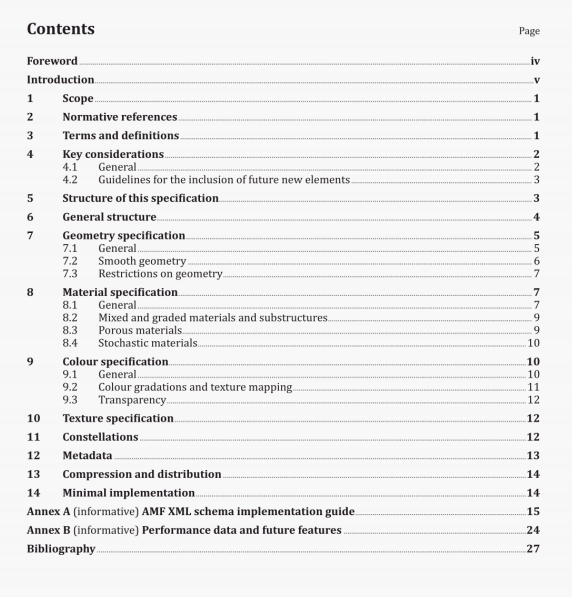ISO ASTM 52915:20 pdf download.Specification for additive manufacturing file format (AMF) Version 1.2.
4.1.2 Technology independence. The AMP describes an object in such a general way that any machine can build it to the best of its ability It is resolution and layer-thickness independent and does not contain information specific to any one manufacturing process or technique. This does not negate the inclusion of features that descrihe capabilities that only certain advanced machines support (for example colour. multiple materials), but these are defined in such a way as to avoid exclusivity
4.1.3 SimplicIty. The AMF Is easy to implement and understand. The format can be read and debugged in a simple text viewer to encourage comprehension and adoption. Identical Information is nut stored in multiple places.
4.1.4 Scalabillty. The file size and Processing time scales well with the Increase in part complexity and with the Improving resolution and accuracy of manufacturing equipment. This includes being able to handle large arrays of identical objects, complex periodic Internal features (for example meshes and lattices) and smooth curved surfaces when fabricated wnh very high resolution.
4.1.5 Performance. The AMF enables reasonable duration (interactive time) for read-and-write operations and reasonable tile sizes for a typical large object. l)etailed performance data are provided in Annex B.
4.1.6 Backwards compatibility. Any existing STL file can be converted directly into a valid AMF file without any loss of information and without requiring any additional information. AMF flies are also easily converted back to STL for use on legacy systems, although advanced features will be lost. This format maintains the triangle-mesh geometry representation to take advantage of existing optimized slicing algorithms and code infrastructure already in existence.
4.1.7 Future compatibility To remain useful in a rapidly changing industrc this file format is easily extensible while remaining conipatible with earlier versions and technologies. This allows new features to be added as advances In technolo’ warrant, while still working flawlessly for simple homogeneous geometries on the oldest hardware.
4.2 GuidelInes for the Inclusion of future new elements
4.2.1 Any new element proposed shall be applicable across all hardware platforms and technologies that could conceivably be used to generate the desired outcome.
4.2.2 In support of the consideration above, new elements proposed for this document shall describe the final obieci, not how to build it, For instance, a hypothetical future element – might be allowed to tell an additive manufacturing system to leave the volume empty if possible. However, an element ob i r’LsyerFil 1 path that describes how to build a hollow volume shall not be Included since It assumes a particular fabrication process.
5 Structure of (his specification
5.1 Format. Information specified throughout this specification is stored in XMl. 1.0 formaL XML is a text file comprising a list of elements and attributes. lJsing this widely accepted data format allows for the use of many tools for creating, viewing, manipulating, parsing and storing AMF tiles. XML is human- readable, which makes debugging errors in the tile possible. XML can be compressed or encrypted or both if desired in ,i post-processing step mixing highly optimized standardized routines.
ISO ASTM 52915:20 pdf download
